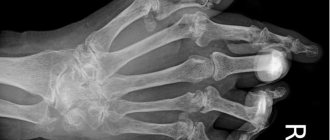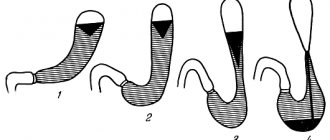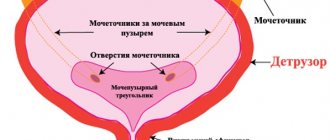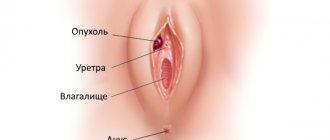What is phimosis in men?
The disease phimosis of the foreskin is a narrowing of the extreme skin fold located at the head of the penis. In a normal state, it is able to fully open the head during an erection, while hiding it in a calm state. The skin moves easily and painlessly without blocking the urethra or preventing urination.
The space between the foreskin and the skin of the glans is called the prepuncial cavity. A special secret accumulates in it - smegma.
With a normal structure of the foreskin, the amount of smegma is moderate; during hygienic procedures, the secretion is washed off without creating a breeding ground for bacteria. A narrowed skin fold prevents its removal, which provokes various inflammations.
In more than 90% of newborns, the foreskin moves partially or remains motionless, without exposing the head of the penis. This condition is considered normal for infants and does not require medical intervention.
The problem is associated with the presence of embryonic adhesions in the prepuncial sac.
As the child develops, the skin stretches, adhesions dissolve, and the foreskin takes on a normal appearance.
However, phimosis often causes problems.
The narrowed flesh prevents urination, retention of smegma causes inflammation, accompanied by itching and pain. This condition requires treatment under the supervision of a urologist. The ICD 10 (International Classification of Diseases) code for phimosis is No. 47.
From the following articles on our website you can learn more about phimosis and its treatment in order to prevent possible complications and consequences of the disease:
- What is incomplete and relative phimosis, cicatricial and physiological?
- How is phimosis treated?
- home treatment methods;
- difference between phimosis and paraphimosis.
And also, is it possible to have sex if you are sick and do you take them into the army?
How children get sick at different ages
Very often, in the first years after birth, infants may experience a mild form of tightness. Or physiological phimosis. The occurrence of phimosis in newborns is explained by the nuances of the construction of the foreskin. But it is worth noting that the baby, as usual, does not experience any unpleasant or painful sensations.
In this form, it occurs in almost all male babies, so parents should not worry and immediately run to the doctor. Most often, the disease subsides already in the first six months after the birth of a baby. And at 3 years old, phimosis goes away on its own and hardly affects the children. Occasionally, some individual symptoms of the disease may persist even before entering primary school age. But hygienic care plays an important role.
In the event that the main cause of the onset of the disease was non-compliance with the rules of genital hygiene or any injury to the penis, this is already a reason to go to the hospital. Since development in a more serious form will already begin to cause the boy severe pain and other inconveniences. Often this type of contraction occurs in boys of middle or high school age.
Classification and causes
What is the diagnosis of penile phimosis according to the medical classification? Urologists distinguish several types of phimosis of the head. First of all, pathology is divided into congenital and acquired. The cause of congenital phimosis is considered to be a hereditary predisposition associated with reduced tissue elasticity.
The first signs can be noticed a few hours after the baby is born. If the narrowed flesh does not hide the urethra and does not cause pain, treatment is not required, but the child should be under the supervision of a pediatric urologist.
Acquired phimosis can occur at any age. The disease is diagnosed in children, adolescents, young or elderly men. The cause of the pathology may be:
- mechanical damage to the head of the penis;
- failure to comply with hygiene rules;
- inflammatory diseases of the glans penis and foreskin;
- severe diabetes mellitus;
- autoimmune diseases;
- scleroderma of the penis.
Depending on the type of pathology, phimosis of the penis can be atrophic and hypertrophic.
The first form is characterized by the presence of a thin skin that tightly fits the head of the penis with hard edges framing the urethra.
In the case of hypertrophic phimosis, the overgrown foreskin completely covers the penis and hangs down in the form of a narrow proboscis.
Urologists distinguish another type of disease - cicatricial. This is the most severe type of acquired phimosis, occurring after illness, injury, or surgery.
After numerous injuries, the delicate epithelium becomes covered with rough scars; an attempt to move the foreskin is accompanied by severe pain, microtears, and inflammation.
Urologists distinguish 4 degrees of phimosis:
- In the first degree of the disease, the foreskin moves in a calm state; during an erection, complete exposure of the head is impossible, but partial release is allowed. The pain is mild, there are no problems with urination.
- The second stage is characterized by the appearance of pain accompanying any attempt to move the skin fold from the head. In an erect state, the penis is completely covered by the foreskin; at rest, partial release of the upper part of the penis is possible.
- In the third stage, the penis is completely covered with skin, the urethra remains open, but the prepuncial sac is completely closed. Cleaning the skin tissue from accumulated smegma is impossible.
- The fourth stage is especially dangerous. The foreskin closes over the head of the penis, the opening above the urethra narrows greatly. Urine accumulates in the prepuncial cavity, coming out in a thin stream or drops. The patient experiences constant pain, and accumulated urine can cause inflammation.
Possible complications
In addition to possible discomfort and difficulties during hygienic procedures, additional problems and pathologies often appear that require immediate treatment. These include diseases:
- Balanoposthitis is an inflammatory process that occurs in the foreskin and the end of the penis. Occurs due to poor hygiene. The patient develops the following symptoms: itching, discharge of purulent accumulations, hyperemia, pain.
- Paraphimosis occurs when parents try to expose the head of the penis on their own. Sudden and incorrect movements lead to forced stretching of the foreskin and subsequent compression of the genital organ. Blood vessels and tissues suffer from this. The patient experiences severe pain, the tip of the penis increases in size and swells. If the disease is not treated in time, necrosis or gangrene of the genital organ may develop. The way out of this situation is amputation of the affected area.
- Fusion of the foreskin and the head occurs if no measures are taken for a long time to eliminate phimosis - synechiae (fusions) gradually form (we recommend reading: synechiae in boys: symptoms and treatment). In this condition, it is impossible to fix the problem on your own.
Treatment regimen
Initial degrees of phimosis can be treated with conservative methods . Urologists usually suggest a combination of corticosteroid ointments, herbal baths and lotions, and self-massage. The course is calculated individually and depends on the stage of phimosis, the patient’s condition, and the presence or absence of other chronic diseases.
Baths and lotions are prepared from plants with anti-inflammatory, regenerating, calming effects.
They make the skin softer and more elastic, reduce pain, and prevent microdamage. You can use pharmaceutical chamomile, calendula, nettle, sage, coltsfoot, and birch leaves.
The water should be warm, the procedure lasts 7-10 minutes, it is better to do it before bed. During the bath, you can gently pull back the foreskin; warm water helps make this as painless as possible.
The ointment is applied to the head of the penis and gently rubbed in. The process is combined with massage. The foreskin is carefully pulled back and rubbed in a circular motion. You can't be overzealous. Intense sudden movements can damage the delicate epithelium or provoke the development of paraphimosis (pinching of the head of the penis).
Massage and application of ointments are carried out daily; treatment can last several months and does not always lead to the desired result.
In addition, the constant use of potent drugs can cause changes in the genitourinary system and cause problems with the immune system.
Only circumcision (circumcision) will help completely get rid of phimosis. The foreskin is excised partially or completely; during the operation, plastic surgery of a shortened frenulum is possible.
This procedure is performed in a hospital or on an outpatient basis; children and adolescents are given general anesthesia; operations in adult men are performed under local anesthesia. The rehabilitation period takes several weeks and usually passes without complications.
On our website you will find many useful articles about the male circumcision procedure. Here are some of them:
- types of circumcision: including features of partial and high tight circumcision;
- up to what age can it be done?
- pros and cons of the procedure;
- what does the penis look like “before” and “after”;
- all about care after surgery;
- specifics of removing the foreskin using a laser;
- After what time is it allowed to masturbate and have sex?
Read about circumcision for religious reasons, as well as which nationalities accept it and what the Bible interprets in this publication.
How does the disease develop and why is it dangerous?
What is the disease phimosis of the penis in an advanced state? Even phimosis that does not cause discomfort needs to be monitored by a urologist. The narrowed foreskin makes it impossible to carry out hygienic procedures; accumulated smegma causes inflammation and can cause anaerobic or candidal balanitis or balanoposthitis. In turn, purulent posthitis can cause secondary phimosis.
Constant inflammation can provoke further narrowing of the foreskin. In particularly severe cases, normal urination becomes impossible.
Urine accumulates in the cavity between the foreskin and the skin of the penis, coming out drop by drop. This condition requires immediate surgical intervention, otherwise unpleasant consequences may occur, including tissue necrosis.
Phimosis is an obstacle to normal sexual life . This reason often becomes decisive for young people with congenital pathology. Discomfort during sexual intercourse can provoke a whole list of problems, from early ejaculation to impotence or prostatitis.
Timely diagnosis and proper treatment of phimosis can completely solve the problem. In case of advanced pathology, only surgery can help; it will not only remove excess foreskin, but also prevent serious complications.
History of the diagnosis
Physiological phimosis in children, as a rule, disappears spontaneously and without a trace by the age of 5. But there are cases when the head at a given age in boys cannot freely come out of the narrow opening of the foreskin. According to doctors, deviations from the norm are possible in some cases in children under 12 years of age.
If the head does not come out with age and the problem remains in boys during puberty, then it requires eradication, and sometimes surgery. Although, of course, everything is at the discretion of the doctor. There are other more gentle non-drug methods for treating phimosis in boys.











